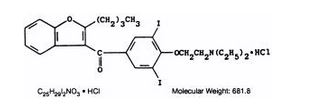Cordarone tablet description
Editor-In-Chief: C. Michael Gibson, M.S., M.D. [1]; Associate Editor(s)-in-Chief: Ahmed Zaghw, M.D. [2]
Description
Cordarone (amiodarone HCl) is a member of a class of antiarrhythmic drugs with predominantly Class III (Vaughan Williams' classification) effects, available for oral administration as pink, scored tablets containing 200 mg of amiodarone hydrochloride. The inactive ingredients present are colloidal silicon dioxide, lactose, magnesium stearate, povidone, starch, and FD&C Red 40. Cordarone is a benzofuran derivative: 2-butyl-3-benzofuranyl 4-[2-(diethylamino)-ethoxy]-3,5-diiodophenyl ketone hydrochloride.
The structural formula is as follows:

|
Amiodarone HCl is a white to cream-colored crystalline powder. It is slightly soluble in water, soluble in alcohol, and freely soluble in chloroform. It contains 37.3% iodine by weight.
References
Adapted from the FDA Package Insert.